[English] 日本語
 Yorodumi
Yorodumi- PDB-1jog: Structure of HI0074 from Heamophilus Influenzae reveals the fold ... -
+ Open data
Open data
- Basic information
Basic information
| Entry | Database: PDB / ID: 1jog | ||||||
|---|---|---|---|---|---|---|---|
| Title | Structure of HI0074 from Heamophilus Influenzae reveals the fold of a substrate binding domain of a nucleotidyltransferase | ||||||
 Components Components | HYPOTHETICAL PROTEIN HI0074 | ||||||
 Keywords Keywords | STRUCTURAL GENOMICS / UNKNOWN FUNCTION / HI0074 / hypothetical protein / Structure 2 Function Project / S2F | ||||||
| Function / homology |  Function and homology information Function and homology informationendonuclease activity / Hydrolases; Acting on ester bonds / nucleotide binding Similarity search - Function | ||||||
| Biological species |  Haemophilus influenzae (bacteria) Haemophilus influenzae (bacteria) | ||||||
| Method |  X-RAY DIFFRACTION / X-RAY DIFFRACTION /  SYNCHROTRON / SYNCHROTRON /  MAD / Resolution: 2.4 Å MAD / Resolution: 2.4 Å | ||||||
 Authors Authors | Lehmann, C. / Lim, K. / Herzberg, O. / Structure 2 Function Project (S2F) | ||||||
 Citation Citation |  Journal: Proteins / Year: 2003 Journal: Proteins / Year: 2003Title: The HI0073/HI0074 protein pair from Haemophilus influenzae is a member of a new nucleotidyltransferase family: Structure, sequence analyses, and solution studies Authors: Lehmann, C. / Lim, K. / Chalamasetty, V.R. / Krajewski, W. / Melamud, E. / Galkin, A. / Howard, A. / Kelman, Z. / Reddy, P.T. / Murzin, A.G. / Herzberg, O. | ||||||
| History |
|
- Structure visualization
Structure visualization
| Structure viewer | Molecule:  Molmil Molmil Jmol/JSmol Jmol/JSmol |
|---|
- Downloads & links
Downloads & links
- Download
Download
| PDBx/mmCIF format |  1jog.cif.gz 1jog.cif.gz | 123.6 KB | Display |  PDBx/mmCIF format PDBx/mmCIF format |
|---|---|---|---|---|
| PDB format |  pdb1jog.ent.gz pdb1jog.ent.gz | 99.1 KB | Display |  PDB format PDB format |
| PDBx/mmJSON format |  1jog.json.gz 1jog.json.gz | Tree view |  PDBx/mmJSON format PDBx/mmJSON format | |
| Others |  Other downloads Other downloads |
-Validation report
| Summary document |  1jog_validation.pdf.gz 1jog_validation.pdf.gz | 457.8 KB | Display |  wwPDB validaton report wwPDB validaton report |
|---|---|---|---|---|
| Full document |  1jog_full_validation.pdf.gz 1jog_full_validation.pdf.gz | 489.3 KB | Display | |
| Data in XML |  1jog_validation.xml.gz 1jog_validation.xml.gz | 29.7 KB | Display | |
| Data in CIF |  1jog_validation.cif.gz 1jog_validation.cif.gz | 39 KB | Display | |
| Arichive directory |  https://data.pdbj.org/pub/pdb/validation_reports/jo/1jog https://data.pdbj.org/pub/pdb/validation_reports/jo/1jog ftp://data.pdbj.org/pub/pdb/validation_reports/jo/1jog ftp://data.pdbj.org/pub/pdb/validation_reports/jo/1jog | HTTPS FTP |
-Related structure data
| Similar structure data | |
|---|---|
| Other databases |
- Links
Links
- Assembly
Assembly
| Deposited unit | 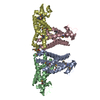
| ||||||||
|---|---|---|---|---|---|---|---|---|---|
| 1 | 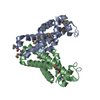
| ||||||||
| 2 | 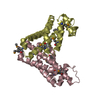
| ||||||||
| Unit cell |
| ||||||||
| Details | Probably a dimer. The asymmetric unit contains two dimers. |
- Components
Components
| #1: Protein | Mass: 17518.633 Da / Num. of mol.: 4 Source method: isolated from a genetically manipulated source Source: (gene. exp.)  Haemophilus influenzae (bacteria) / Gene: HI0074 / Plasmid: pRE1 / Production host: Haemophilus influenzae (bacteria) / Gene: HI0074 / Plasmid: pRE1 / Production host:  #2: Water | ChemComp-HOH / | Has protein modification | Y | |
|---|
-Experimental details
-Experiment
| Experiment | Method:  X-RAY DIFFRACTION / Number of used crystals: 1 X-RAY DIFFRACTION / Number of used crystals: 1 |
|---|
- Sample preparation
Sample preparation
| Crystal | Density Matthews: 1.97 Å3/Da / Density % sol: 37.59 % | |||||||||||||||||||||||||||||||||||||||||||||||||||||||||||||||
|---|---|---|---|---|---|---|---|---|---|---|---|---|---|---|---|---|---|---|---|---|---|---|---|---|---|---|---|---|---|---|---|---|---|---|---|---|---|---|---|---|---|---|---|---|---|---|---|---|---|---|---|---|---|---|---|---|---|---|---|---|---|---|---|---|
| Crystal grow | Temperature: 294 K / Method: vapor diffusion, hanging drop / pH: 8 Details: 30% PEG 4000, 0.1 M Tris, 0.2 M Na acetate, pH 8.0, VAPOR DIFFUSION, HANGING DROP, temperature 294K | |||||||||||||||||||||||||||||||||||||||||||||||||||||||||||||||
| Crystal grow | *PLUS pH: 7.5 | |||||||||||||||||||||||||||||||||||||||||||||||||||||||||||||||
| Components of the solutions | *PLUS
|
-Data collection
| Diffraction | Mean temperature: 100 K | ||||||||||||
|---|---|---|---|---|---|---|---|---|---|---|---|---|---|
| Diffraction source | Source:  SYNCHROTRON / Site: SYNCHROTRON / Site:  APS APS  / Beamline: 17-ID / Wavelength: 0.9791, 0.9793, 1.00 / Beamline: 17-ID / Wavelength: 0.9791, 0.9793, 1.00 | ||||||||||||
| Detector | Type: MARRESEARCH / Detector: CCD / Date: Mar 30, 2001 / Details: mirror | ||||||||||||
| Radiation | Monochromator: Si (111) double crystal system / Protocol: MAD / Monochromatic (M) / Laue (L): M / Scattering type: x-ray | ||||||||||||
| Radiation wavelength |
| ||||||||||||
| Reflection | Resolution: 2.4→30 Å / Num. all: 22467 / Num. obs: 22467 / % possible obs: 99.6 % / Observed criterion σ(F): 0 / Observed criterion σ(I): 0 / Redundancy: 3.9 % / Rmerge(I) obs: 0.067 / Net I/σ(I): 6.8 | ||||||||||||
| Reflection shell | Resolution: 2.4→2.51 Å / Rmerge(I) obs: 0.314 / % possible all: 100 | ||||||||||||
| Reflection | *PLUS Lowest resolution: 30 Å |
- Processing
Processing
| Software |
| ||||||||||||||||||||
|---|---|---|---|---|---|---|---|---|---|---|---|---|---|---|---|---|---|---|---|---|---|
| Refinement | Method to determine structure:  MAD / Resolution: 2.4→20 Å / Cross valid method: THROUGHOUT / σ(F): 2 / Stereochemistry target values: Engh & Huber MAD / Resolution: 2.4→20 Å / Cross valid method: THROUGHOUT / σ(F): 2 / Stereochemistry target values: Engh & Huber
| ||||||||||||||||||||
| Displacement parameters | Biso mean: 57 Å2 | ||||||||||||||||||||
| Refinement step | Cycle: LAST / Resolution: 2.4→20 Å
| ||||||||||||||||||||
| Refine LS restraints |
| ||||||||||||||||||||
| LS refinement shell | Resolution: 2.4→2.49 Å / Rfactor Rfree: 0.334 / Rfactor Rwork: 0.258 | ||||||||||||||||||||
| Refinement | *PLUS Lowest resolution: 20 Å | ||||||||||||||||||||
| Solvent computation | *PLUS | ||||||||||||||||||||
| Displacement parameters | *PLUS | ||||||||||||||||||||
| Refine LS restraints | *PLUS Type: c_angle_deg / Dev ideal: 2.1 |
 Movie
Movie Controller
Controller



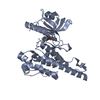
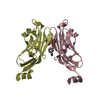

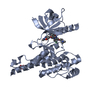
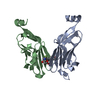

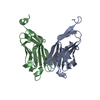
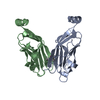

 PDBj
PDBj
